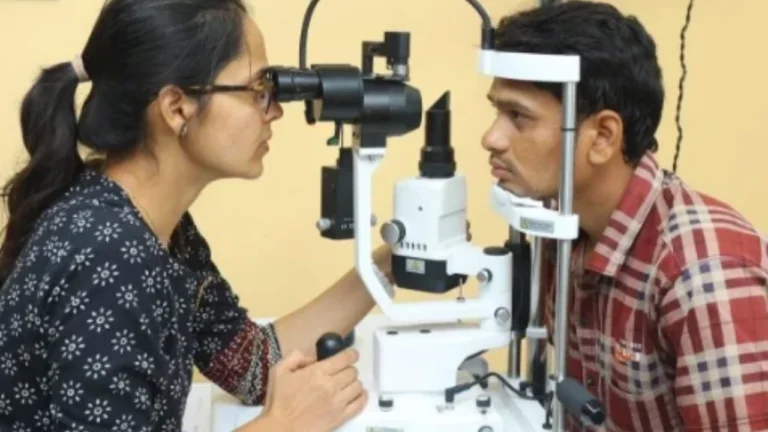
High Myopia, Lattice Degeneration & Barrage Laser Before Cataract Surgery
Patients with high myopia (especially very high myopes) often show peripheral retinal changes like lattice degeneration. Because high myopes already have a higher baseline risk of retinal detachment after cataract surgery [4], patients commonly ask whether prophylactic barrage (laser) treatment is necessary before surgery.
Retinal Detachment Risk in High Myopes
In the general population, retinal detachment risk after cataract surgery is about 0.4–1% over a few years [4]. In high myopes, the risk is several times higher, particularly in younger males and those with lattice degeneration [5].
Do All Lattice Degenerations Need Barrage Laser?
No. International guidelines recommend selective treatment:
– **Treat**: symptomatic tractional tears, acute PVD with a tear, progressive lesions, traumatic breaks, or when the fellow eye has had a detachment [1].
– **Do not treat routinely**: asymptomatic lattice degeneration or atrophic holes without traction [2][3].
Cochrane reviews and AAO Preferred Practice Patterns confirm that there is no strong evidence that lasering every asymptomatic lattice prevents detachment [1][2]. Hence, the decision must be individualized after retinal examination.
Practical Approach
- Careful retinal examination with scleral depression before cataract surgery.
2. Targeted barrage laser if lesions are high risk [1].
3. Wait 1–2 weeks after laser before cataract surgery to allow adhesion.
4. Counsel the patient about risk and warning symptoms (sudden floaters, flashes, dark curtain).
5. Ensure regular follow-up after surgery.
Conclusion
Most high myopes do well after cataract surgery. Routine barrage laser for every lattice is not required. Selective, evidence-based treatment ensures safety while avoiding unnecessary procedures [1][2][3].
हाई मायोपिया, लैटिस डीजेनरेशन और मोतियाबिंद से पहले बैरेज लेज़र
हाई मायोपिया (विशेषकर बहुत अधिक मायोपिया) वाले मरीजों में रेटिना के किनारे पर **लैटिस डीजेनरेशन** जैसी परिवर्तन अक्सर देखे जाते हैं। चूंकि ऐसे मरीजों में मोतियाबिंद सर्जरी के बाद रेटिना डिटैचमेंट का खतरा सामान्य लोगों की तुलना में अधिक होता है [4], इसलिए वे अक्सर पूछते हैं कि क्या ऑपरेशन से पहले बैरेज (लेज़र) ज़रूरी है।
हाई मायोप्स में रेटिना डिटैचमेंट का जोखिम
सामान्य आबादी में मोतियाबिंद ऑपरेशन के बाद RD का खतरा लगभग 0.4–1% तक होता है [4]। हाई मायोप्स में यह जोखिम कई गुना अधिक होता है, खासकर कम उम्र के पुरुषों और जिनमें लैटिस डीजेनरेशन होता है [5]।
क्या हर लैटिस पर बैरेज लेज़र ज़रूरी है?
नहीं। अंतरराष्ट्रीय गाइडलाइन्स **चयनात्मक उपचार** की सलाह देती हैं [1][2]:
– **लेज़र करें**: यदि लक्षणयुक्त हॉर्सशू टियर हो, एक्यूट PVD के साथ टियर हो, प्रोग्रेसिव लीजन हो, ट्रॉमैटिक ब्रेक हो या साथी आँख में RD हो चुका हो [1]।
– **रूटीन लेज़र न करें**: बिना लक्षण वाली लैटिस डीजेनरेशन या ट्रैक्शन रहित एट्रोफिक होल [2][3]।
AAO और Cochrane रिव्यू में भी यही निष्कर्ष है कि हर असिंप्टोमैटिक लैटिस पर लेज़र करना जरूरी नहीं है [1][2]। निर्णय हमेशा रेटिना जांच के आधार पर होना चाहिए।
व्यावहारिक दृष्टिकोण
- ऑपरेशन से पहले रेटिना की गहन जांच (स्लेरल डिप्रेशन सहित)।
2. केवल उच्च-जोखिम वाले मामलों में ही बैरेज लेज़र [1]।
3. लेज़र के बाद 1–2 सप्ताह प्रतीक्षा कर ऑपरेशन करें।
4. मरीज को RD के लक्षणों के बारे में शिक्षित करें (अचानक फ्लोटर्स, चमक, काला पर्दा)।
5. ऑपरेशन के बाद नियमित फॉलो‑अप।
निष्कर्ष
अधिकांश हाई मायोप मरीज सुरक्षित रूप से मोतियाबिंद ऑपरेशन करवा सकते हैं। हर लैटिस पर रूटीन लेज़र करना ज़रूरी नहीं है [1][2][3]। केवल उच्च जोखिम वाले घावों पर लक्षित लेज़र करना ही उचित और वैज्ञानिक तरीका है।
संदर्भ (References – Scientific Sources in English)
[1] AAO Preferred Practice Pattern: Posterior Vitreous Detachment, Retinal Breaks & Lattice Degeneration (2024–2025).
[2] Cochrane Review (2014): Interventions for asymptomatic retinal breaks and lattice degeneration.
[3] RANZCO Choosing Wisely (2022): ‘No indication for prophylactic treatment of asymptomatic lattice/atrophic holes.’
[4] Erie JC. Population-based risk of retinal detachment after cataract surgery. Ophthalmology. 2006.
[5] Ang A, et al. Retinal detachment after phaco in high myopia. J Cataract Refract Surg. 2007.
About Saluja Eye Care Center, Indore
Established in 2008, Saluja Eye Care Center is a NABH-accredited eye hospital in Indore, trusted for advanced cataract, glaucoma, retina, cornea, refractive and children’s eye care. We are consistently ranked among the top eye hospitals in Madhya Pradesh, delivering superior care with ethical, patient-centered service.
सालुजा आई केयर सेंटर, इंदौर के
बारे में
2008 में स्थापित, सालुजा आई केयर सेंटर इंदौर का NABH मान्यता प्राप्त नेत्र चिकित्सालय है, जहाँ मोतियाबिंद, ग्लूकोमा, रेटिना, कॉर्निया, रिफ्रैक्टिव और बच्चों की आँखों के लिए आधुनिक एवं सुरक्षित उपचार उपलब्ध हैं। मध्यप्रदेश के शीर्ष नेत्र केंद्रों में से एक, हमारा वचन है – नैतिक और मरीज-केंद्रित देखभाल।
Superior Care, Trustworthy Service (श्रेष्ठ चिकित्सा, विश्वसनीय सेवा)
For Appointments/अपॉइंटमेंट के लिए:
Timings: Monday to Saturday, 11 AM – 8 PM (By Prior Appointment)
समय: सोमवार से शनिवार, सुबह 11 से रात 8 बजे (पूर्व अपॉइंटमेंट पर)
